🇬🇧⎪Estonia has goals to reach the SDGs by 2030!
- Fabian Collinet

- Sep 8, 2020
- 3 min read
Updated: Nov 14, 2020
After discovering the SDGs’ matrix, its challenges, its interests, … (Click here to discover the 1st step of our approach “SEE” with our posts dedicated to each SDG) Here is the 2nd step of our approach SEE, ANALYZE, ACT & SHARE! It consists to find out the SDGs international applications to understand the specific challenges in the different states where we are going to. Here is the ANALYZE step and it ends with Estonia!

ESTONIA PROFILE
- Capital: Tallin
- Number of inhabitants: 1.329 million
- Currency: Euro
- Official language: Estonian (current language : russian)
- President: Kersti Kaljulaid, since October 2016 is the country's first woman and youngest head of state.
- Government: Parliamentary Democracy
- GDP: 2020 estimated GDP per capital: $37,605 (World Bank), around 39th worldwide rank
- HDI: 2018 HDI: 0.88, ranked the 30th worldwide (high ranking).
- Gini: 2018 Gini: 30.6% (represents the income inequality or wealth inequality within a nation)
- Climate & geography: The Baltic Sea causes great differences in climate between coastal and mainland areas. The climate is characterized by a cold winter, a mild and somewhat rainy spring, a relatively hot summer and a long, mild autumn. Estonia's high latitude results in a significant difference in daylight between winter and summer. The days are shorter at the winter solstice: Tallinn 06h02 min day / 17h58 min at night. Estonia is a country of marshy lowlands. 48% of the country is made up of woods and forests and 13% of marshes. Estonia also has more than 1,400 lakes and around 150 rivers.
- Economic situation:
(+) Estonia is the first former Soviet country to join the OECD in May 2010.
(+) The tertiary sector: Services (including transport and logistics, biotechnology and financial services) account for 60.4% of Estonian GDP. The ICT sector is the best performing, accounting for around 7% of total GDP.
(-) The IMF predicts a further fall in the Estonian economy in 2020, with an expected growth rate of -7.5%, due to the outbreak of the COVID-19 pandemic
(-)According to Statistics Estonia, 21.7% of Estonian population was at risk of poverty in 2018
- Health care: Universal health care ranked 77th/191 by the World Health Organization
Estonia’s international commitment to contribute to reach the SDGs by 2030
Devoted to the UN Agenda, Estonia realized for the second time a VNR (Voluntary National Review) in 2020. Advancements can also be appreciated in the online data-driven “Tree of Truth” that illustrates the status of the goals by governance areas. In fact, in 2018, the list of Estonian Sustainable Development Indicators was renewed to harmonise it with the SDGs! (Click here to discover the Estonia’s Tree of truth and its goals’ advancements). Especially, with the “Estonia 2035” strategy launched in 2019, Estonia makes SDGs the basis of its long-term strategic objectives and development plans. Incredible fact, Estonia has an 18th goal that aim to maintain the viability of the Estonian cultural space! This goal permits to align the “Sustainable Estonia 21” strategy from 2005 with the SDGs included in “Estonia 2035”:
1. People smart, active healthy (SDGs 2,3,4)
2. Society open, caring, cooperative (SDGs 1,5,10,*18*)
3. Economy strong, innovative, responsible (SDGs 2,7,8,9,12,13)
4. Environment by taking into account the needs of all, safe, high-quality (SDGs 6,9,11,12,13,14,15)
5. Governance innovative, reliable, human-centered (SDGs 11,16,17)

Main challenges for Estonia on the way to the SDGs
To meet the goals by 2030, Estonia must deal with the following challenges of the sustainable development:
On the Economic pillar:
- Achieve the average level of productivity in the European Union or even above it by 2035
- Generate innovation to develop environmentally friendly technologies and green business models, especially based on the circular economy which enhance the use of local resources and secondary raw materials
On the Social pillar:
- Establish gender equality (the wage gap still remains among the highest in Europe)
- Decrease the risk of poverty for women and disabled people, including families with disabled children
- Improve health of the citizens, including mental health and decrease the number of preventable deaths
On the Environmental pillar:
- Establish effective waste management and recycling
- Decrease greenhouse emissions
- Maintain natural diversity

Is Estonia on the right path to contribute to reach the SDGs?
A successful integration of the agenda 2030 within the national strategy, such as the state’s strengths in accessible and quality education, effective healthcare organisation, high employment rate with minimal long-term unemployment, and in a high proportion of renewable energy in overall energy consumption permits Estonia to be ranked 10th out of 156 countries in 2019 according to the SDG index! However, challenges mentioned above need to be faced faster in Estonia to enforce the movement necessary to reach the SDGs by 2030!
References:
For more information, please visit the websites:




Comments